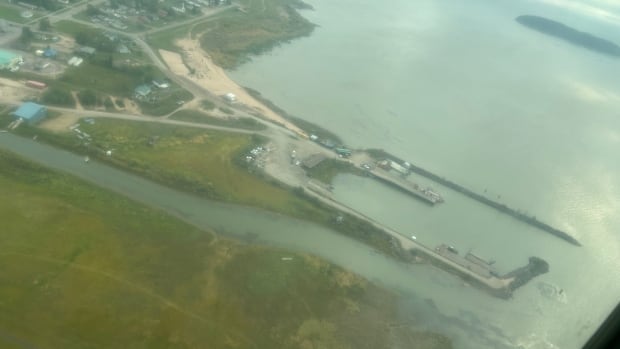Three northern Alberta Indigenous groups say the federal government has kept them in the dark about a contaminated dock site in their community.
The Big Dock, as it’s known in Fort Chipewyan, is owned by Transport Canada.
The dock is used for commercial purposes, but Allan Adam, chief of Athabasca Chipewyan First Nation, said the hamlet’s residents also use it for “swimming, fishing, hunting, trapping and harvesting.”
Important facility for potential evacuations
The community leaders became aware of the dock’s contamination this summer, after they learned of a report produced by a third-party contractor in 2017.
The dock is important for the community, as it can be used for evacuations during wildfires.
In August, leaders of Athabasca Chipewyan First Nation, Mikisew Cree First Nation and Fort Chipewyan Métis wrote a letter to the then-minister of Transport, Pablo Rodriguez.
“The Transport Canada dock in downtown Fort Chipewyan is the only alternative to the airport if the community is placed under an urgent evacuation alert,” they wrote, particularly if evacuation by air is not possible.
“We had low water tables this year,” Adam said in an interview with CBC, and they were concerned that they wouldn’t be able to use it for evacuations, if the need arose.
“Due to a lack of maintenance, your refusal to dredge the surrounding area, and low water levels in the Peace-Athabasca Delta, the Transport Canada dock is not up to standard for the needs of the community,” community leaders wrote in their letter to Rodriguez.
Adam said they asked Transport Canada to fix the issue, but the department didn’t do it.
“We went ahead and we said that we were going to go ahead with the contracting of the remediation of the dock to repair it, so we would be able to dredge the canal to the channel.”
Contamination discovered in 2017 report
Once they found the contractor, Adam said, the company revealed to them that there were “heavy contaminants in the area,” based on the 2017 report.
Adam said Transport Canada failed to notify the community about this issue.
“The community is very concerned about the findings,” he said.
“We’re very scared now, finding this out, because a lot of us allow our kids to go into those waters for recreational use, because we know that, being a remote community, kids will access any waters that they can,” said Billy-Joe Tuccaro, Chief of Mikisew Cree First Nation.
Athabasca Chipewyan First Nation commissioned their own studies of the area. One of them, conducted by Stantec, discovered hydrocarbon and metal contamination in the sediment on the bottom of the dock, and metal contamination of the water there. Among the contaminants, the study found cadmium, arsenic, iron and copper, and among hydrocarbons: pyrene, chrysene and fluorene.
Michael Serpe is a professor of chemistry at the University of Alberta who reviewed the results of Stantec’s study for CBC. He said “a number of the values that were acquired as part of the study do indeed show that the levels of some of these species were above the guideline levels.”
He said that a number of substances identified in the report “are indeed toxic, especially for human consumption over long periods of time,” such as, for instance, daily consumption of water contaminated with them over the course of decades.
“That being said,” he said, “this is not water that’s being consumed by people in these communities every day, over many decades.”
Serpe believes the risk to humans from the Big Dock “is quite minimal.”
Feds keeping mum, Adam alleges
Adam is frustrated with what he says is the lack of communication from Transport Canada.
“It’s astonishing it continues to happen in this day and age,” he said.
He says the federal government has done “nothing at this point in time” to address the issue.
“And if they did, and if they are doing something — they haven’t released any information to us.”
In a statement to CBC, Transport Canada said that 2017 risk assessment “investigated risks to human health and wildlife, and the study determined that the site was not likely to pose any risks to human health.”
The statement also says that the risk assessment “also considered a variety of uses such as, swimming and fishing.”
Adam disputes that. He says that the 2017 report only considers the commercial use of the site and doesn’t reflect the fact that residents of Fort Chipewyan use it for other purposes as well.
In a statement to CBC, the office of Minister of Transport Anita Anand said, “our government is working with the local First Nations community to ensure that operations at the port facility are carried out safely. Remote and Indigenous communities must have access to the safe and reliable connectivity that they need.”


